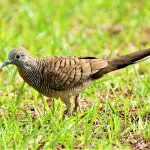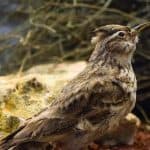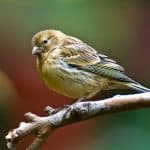Common Name: Common Waxbill
Scientific Name: (Estrilda astrild)| Size | Diet | Range in Hawaii | Status in Hawaii |
|---|---|---|---|
| 4 in. - 4.5 in. | seeds | O'ahu, Maui, and Big Island | Least Concern |
The Common Waxbill (Estrilda astrild), also known as the St. Helena Waxbill, is a small and colorful bird species that is native to sub-Saharan Africa. With its striking red and black plumage and cheerful chirping, this bird is a beloved sight in its natural habitat. However, the species has also established itself as a naturalized (non-native) resident in Hawaii, where it was recently introduced in the early 2000s.
In this article, we’ll explore the fascinating world of the Common Waxbill, its unique adaptations, and its behavior in the wild. We’ll also learn about its recent establishment in Hawaii, the reasons for its introduction, and the impact of non-native species on Hawaii’s native flora and fauna.
Common Waxbill
Appearance
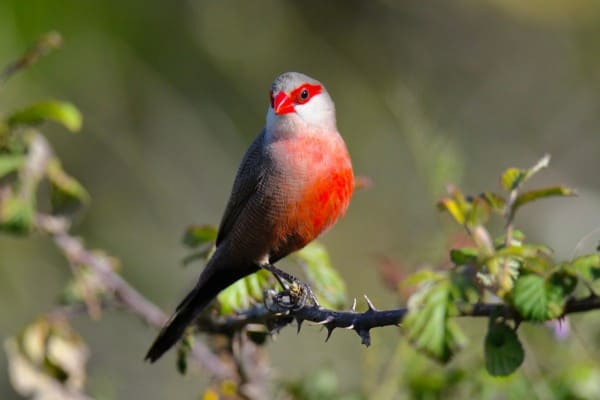
The Common Waxbill is a small bird with a distinctive appearance. It measures approximately 4-4.5 inches (10-11.5 cm) in length.
The plumage of the Common Waxbill is characterized by vibrant colors and intricate patterns. It has a brownish-red back, a pale belly, and a black tail.
The head and neck are adorned with a striking combination of red, black, and white markings. The cheeks and throat display a deep red coloration, while the beak is bright red.
Both males and females have a similar appearance, although males may exhibit slightly brighter and more intense colors, particularly on the face and breast. The young birds have a more subdued coloration and less defined markings compared to adults.
Diet
The Common Waxbill has a primarily granivorous diet, meaning it primarily feeds on seeds. Seeds from various grasses, grains, and small plants make up a significant portion of its diet. It also has a fondness for millet seeds, which are often provided in bird feeders.
In addition to seeds, the Common Waxbill may consume small insects and their larvae, especially during the breeding season when protein-rich food is crucial for their offspring’s growth. These insects can include small beetles, caterpillars, and termites.
Common Waxbills are also known to feed on ripe fruits, particularly berries. Their small size allows them to easily access and extract the pulp and seeds from fruits. However, seeds remain the primary component of their diet.
Nesting
The Common Waxbill constructs small, intricate nests for breeding purposes. They typically build their nests in dense vegetation, such as grasses, shrubs, or reeds, which provide them with adequate cover and protection.
The nest itself is a compact structure made of grass stems, fine twigs, and other plant materials. The female takes the lead in nest construction, while the male assists by gathering nesting materials and bringing them to the female.
Once the nest is complete, the female lays a clutch of 4 to 6 eggs. The eggs are small and oval-shaped, with a white or pale blue coloration. The female is primarily responsible for incubating the eggs, while the male may take turns to relieve her during this period.
After an incubation period of about 11 to 14 days, the eggs hatch, and the nestlings emerge. Both parents participate in feeding and caring for the young. They regurgitate partially digested food, consisting of small seeds and insects, to feed the hungry nestlings.
The nestlings grow rapidly and develop their feathers within a few weeks. They become fledglings and leave the nest, but the parents continue to provide them with food and guidance as they learn to forage and become independent.
The Common Waxbill may breed throughout the year, depending on the availability of resources and favorable conditions. They can have multiple broods in a season, contributing to their population growth.
Behavior
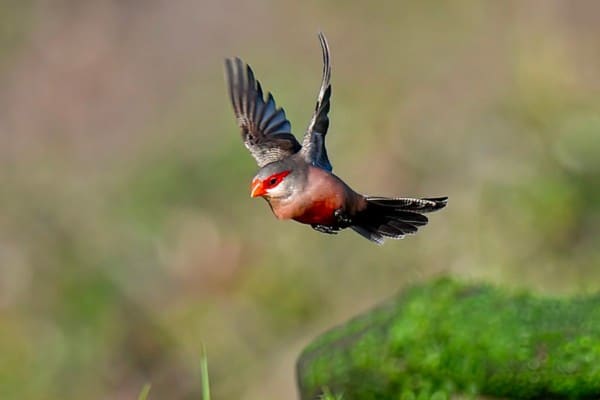
The Common Waxbill is a bird species known for its intriguing behaviors. These social birds are often found in small flocks or pairs, engaging in grooming and playful interactions. Their melodious and repetitive song, consisting of soft chirps and trills, adds to their lively presence.
When it comes to nesting, both male and female Common Waxbills contribute to the construction of intricately woven nests in dense vegetation, usually close to the ground. They exhibit unique feeding behavior, plucking seeds while hovering or hanging upside down from grass stems. Bathing and sunbathing are also part of their routine to keep their feathers clean and maintain their plumage.
During courtship, males perform captivating displays, fluffing their feathers, bobbing their heads, and hopping from perch to perch while singing. In flight, Common Waxbills showcase agile and swift movements, often flying in synchronized patterns with their flock.
When defending their nest, they display alarm calls, aggressive postures, and may engage in aerial pursuits to ward off intruders. These fascinating behaviors make observing Common Waxbills a delightful experience in the wild.
Habitat
The Common Waxbill is a bird species that inhabits a variety of habitats, primarily in grassland and savannah regions. They are commonly found in open areas with grassy vegetation, including grasslands, fields, meadows, and agricultural areas.
These birds are also adaptable and can thrive in both natural and human-altered landscapes. They are often encountered in gardens, parks, and cultivated areas with dense shrubs or tall grasses. The presence of water sources such as ponds, wetlands, or rivers nearby is also beneficial for their habitat selection.
Common Waxbills are typically found in lowland areas, although they can be seen at higher elevations in some regions. They prefer habitats with a mixture of open spaces for foraging and patches of vegetation for nesting and cover.
The availability of food resources is a crucial factor in their habitat selection. Their preference for areas with abundant grass seeds and other small seeds contributes to their presence in grassland habitats and areas with dense vegetation.
Range
The Common Waxbill is a non-native bird species that has been introduced to Hawaii. It has established populations on O’ahu, Maui, and Hawai’i Island. On O’ahu, the population has steadily increased since the 1980s and is now one of the most abundant landbirds on the island, found in various locations.
Common Waxbills have been observed in areas such as Kealia Pond and Olowalu on Maui, often alongside Orange-cheeked Waxbills. On Hawai’i Island, they have spread to multiple locations, including Kona, Captain Cook, and Hilo, with increasing numbers. Continuous monitoring is important to track the distribution and status of these introduced birds in Hawaii.
Conservation Status
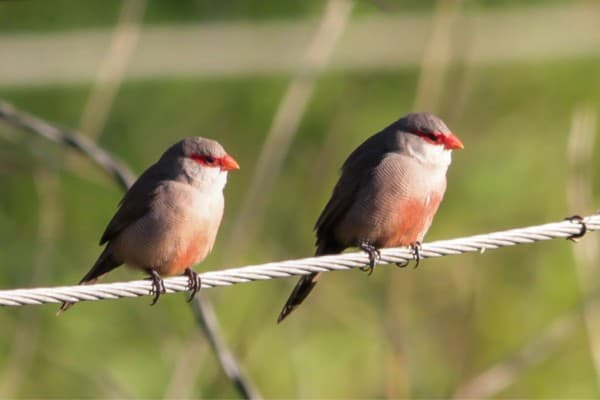
The conservation status of the Common Waxbill is generally considered to be of least concern according to the International Union for Conservation of Nature (IUCN). This is due to its wide distribution and stable populations in its native range across Africa.
However, it’s important to note that the conservation status may vary depending on the specific region or island where it has been introduced, such as in Hawaii or other introduced populations. In these areas, monitoring and assessment of their impact on native species and ecosystems are crucial.
Interesting Facts
1. Social creatures
Common Waxbills are highly social birds that form small flocks or pairs. They engage in various social behaviors, such as grooming each other and participating in playful interactions.
2. Successful introductions
The Common Waxbill has been introduced to various islands around the world, including Hawaii and other remote locations. It has successfully established populations in some of these introduced areas.
3. Agile flight
These birds exhibit swift and agile flight, characterized by direct and coordinated movements. They often fly in small groups, showcasing synchronized flight patterns.
4. Melodious songs
Male Common Waxbills are known for their delightful, repetitive songs consisting of soft chirps and trills. Their melodious vocalizations add to the overall charm of these birds.
Frequently Asked Questions
1. Can Common Waxbills be kept as pets?
Yes, Common Waxbills are popular as aviary birds and can be kept as pets. However, it is essential to ensure proper care, including providing a suitable environment, appropriate diet, and companionship.
2. How long do Common Waxbills live?
In the wild, the lifespan of Common Waxbills is typically around 4 to 6 years. However, in captivity with proper care and nutrition, they may live up to 10 years or more.
3. Do Common Waxbills have any natural predators?
Common Waxbills, like many small bird species, are vulnerable to predation by birds of prey such as hawks and falcons, as well as certain mammals, including snakes and rodents.

